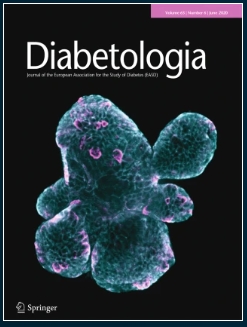Pancreatic cancer-related diabetes and type 2 diabetes differ in multiple aspects of glucose homeostasis.
IF 10.2
1区 医学
Q1 ENDOCRINOLOGY & METABOLISM
引用次数: 0
Abstract
AIMS/HYPOTHESIS Pancreatic ductal adenocarcinoma-related diabetes mellitus (PDAC-DM) is a paraneoplastic syndrome with a poorly understood pathophysiology. PDAC-DM is often clinically confused with type 2 diabetes, resulting in delayed cancer detection and poorly individualised hyperglycaemia treatment. We investigated whether these forms of diabetes can be distinguished at the metabolic level. METHODS Adults with either cancer treatment-naive PDAC-DM (n=28) or type 2 diabetes (n=97), and with diabetes onset within 3 years, underwent mixed-meal tolerance tests to investigate glucose metabolism. Outcomes included insulin sensitivity (Matsuda index), insulin secretion (insulinogenic index), beta cell function (oral disposition index), insulin clearance, and postprandial glucagon, glucagon-like peptide-1 (GLP-1) and glucose-dependent insulinotropic peptide (GIP) responses. RESULTS Compared with type 2 diabetes, individuals with PDAC-DM showed ~2.5-fold greater insulin sensitivity, ~81% lower insulin secretion and ~40% lower beta cell function. Insulin clearance was higher in the PDAC-DM group than the type 2 diabetes group, with and without adjustment for insulin sensitivity. Glucagon and GLP-1 levels increased after a meal in both groups, but levels were higher in the PDAC-DM group. GIP levels were similar between groups. The metabolic differences between groups persisted after adjustment for age, sex and BMI. CONCLUSIONS/INTERPRETATION PDAC-DM and type 2 diabetes are metabolically distinct, with different defects responsible for hyperglycaemia. PDAC-DM is characterised predominantly by insulin deficiency and displays higher insulin sensitivity than type 2 diabetes. There are also differences in alpha cell regulation and insulin clearance compared with type 2 diabetes. These findings identify biological characteristics that may have implications for individualised treatment of PDAC-DM and guide diagnostic biomarker discovery for early PDAC diagnosis.胰腺癌相关糖尿病和2型糖尿病在葡萄糖稳态的多个方面存在差异。
目的/假设胰导管腺癌相关性糖尿病(PDAC-DM)是一种病理生理机制尚不清楚的副肿瘤综合征。PDAC-DM在临床上常与2型糖尿病相混淆,导致癌症检测延迟和高血糖个体化治疗不良。我们研究了这些形式的糖尿病是否可以在代谢水平上区分。方法:患有癌症治疗初期PDAC-DM (n=28)或2型糖尿病(n=97)的成人,并在3年内发病,进行混合膳食耐量试验以研究葡萄糖代谢。结果包括胰岛素敏感性(Matsuda指数)、胰岛素分泌(胰岛素原指数)、β细胞功能(口服处置指数)、胰岛素清除率、餐后胰高血糖素、胰高血糖素样肽-1 (GLP-1)和葡萄糖依赖的促胰岛素肽(GIP)反应。结果与2型糖尿病患者相比,PDAC-DM患者胰岛素敏感性提高2.5倍,胰岛素分泌降低81%,β细胞功能降低40%。无论是否调整胰岛素敏感性,PDAC-DM组的胰岛素清除率都高于2型糖尿病组。两组饭后胰高血糖素和GLP-1水平均升高,但PDAC-DM组的胰高血糖素和GLP-1水平更高。各组间GIP水平相似。在调整了年龄、性别和体重指数后,各组之间的代谢差异仍然存在。结论/解释pdac - dm和2型糖尿病在代谢方面是不同的,有不同的缺陷导致高血糖。PDAC-DM的主要特征是胰岛素缺乏,并表现出比2型糖尿病更高的胰岛素敏感性。与2型糖尿病相比,α细胞调节和胰岛素清除率也存在差异。这些发现确定了可能对PDAC- dm个体化治疗有影响的生物学特征,并指导PDAC早期诊断的诊断性生物标志物的发现。
本文章由计算机程序翻译,如有差异,请以英文原文为准。
求助全文
约1分钟内获得全文
求助全文
来源期刊

Diabetologia
医学-内分泌学与代谢
CiteScore
18.10
自引率
2.40%
发文量
193
审稿时长
1 months
期刊介绍:
Diabetologia, the authoritative journal dedicated to diabetes research, holds high visibility through society membership, libraries, and social media. As the official journal of the European Association for the Study of Diabetes, it is ranked in the top quartile of the 2019 JCR Impact Factors in the Endocrinology & Metabolism category. The journal boasts dedicated and expert editorial teams committed to supporting authors throughout the peer review process.
 求助内容:
求助内容: 应助结果提醒方式:
应助结果提醒方式:


